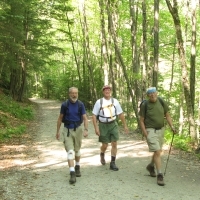 (Host)
(Host)
In his summer of visiting Vermont State Parks, commentator Tom Slayton
has often found traces of history. But none more starkly surprising than
what he found in Jamaica State Park, in southern Vermont.
(Slayton)
Jamaica State Park is a lovely place to walk. What looks like a road,
but was actually once an old railroad bed follows the curve of the West
River, and even in late summer you may hear birds calling from above
you, and the river splashing as it makes its way through the boulders
strewn below.
Each
September whitewater paddlers from all over the Northeast come here for
the annual dam release that swells this splashy little river to a
thundering torrent. But today the river’s low, and we’re out for a walk.
Actually,
this route alongside the river has been walked for a long time. The
West River, which winds its way southeasterly, from Weston down to
Brattleboro, two centuries ago was an important travel corridor for
Native American people between the Connecticut River Valley and Lake
Champlain. Here, in the little valley town that was later named Jamaica,
the river alternates between rocks and riffles, with occasional deep,
blue pools.
One of these, named the Salmon Hole, was a good spot to rest, camp, and catch some high-protein supper.
But
the Salmon Hole wasn’t always an idyllic spot. In late May, 1748, in
fact, it was on the contested frontier between England and France, a
far-flung part of the continuing 18th century wars between those two
European superpowers. A small party of English soldiers that was being
pursued by French and Indians had stopped at the Salmon Hole to rest and
eat. They used their rifles to shoot at the salmon swimming there, and
the sound of their shots brought their pursuers right to them.
Six
of the soldiers were killed and the rest fled in what has become known
as the Salmon Hole Massacre. It wasn’t a crucial battle – just another
deadly incident on the wild North American frontier. It would take
several more years of war before Britain could call this part of the
world New England.
On a
pleasant late-summer day some 264 years later, my friends and I decided
to branch off the West River Trail and climb uphill for about a mile to
the strikingly beautiful – and strikingly dangerous – Hamilton Falls,
where Cobb Brook splashes down over 125 feet of slanted stone ledges on
its way to join the West River. We ate our sandwiches at the top of the
falls, then clambered back down to rejoin the old Railroad bed for the
two mile walk back to where our car waited at the state park campground.
We
eventually got back to the Salmon Hole – today, a peaceful, sunlit spot
where kids splash in the waters of the West River. I took off my hiking
boots, walked across the clean, warm sand, and cooled my tired feet in
its sweet, historic waters.
"Is there any place I’d rather be," I thought, "than right here?"